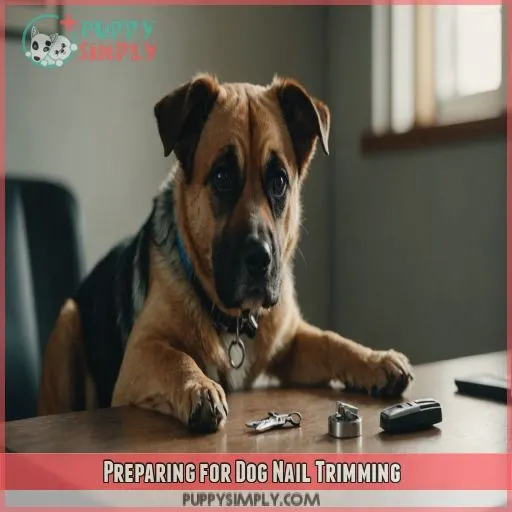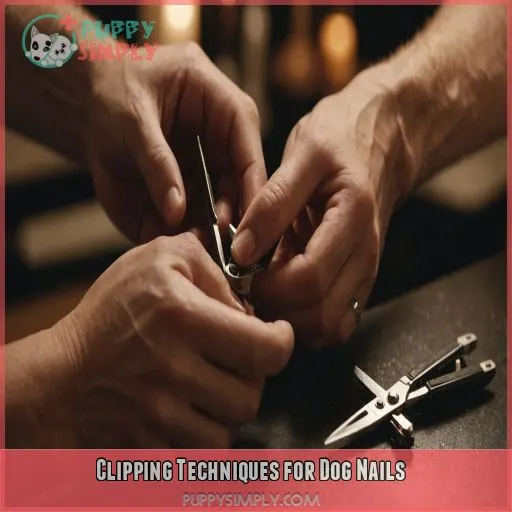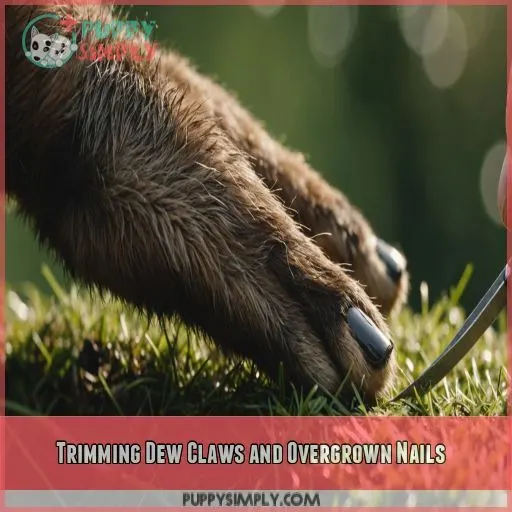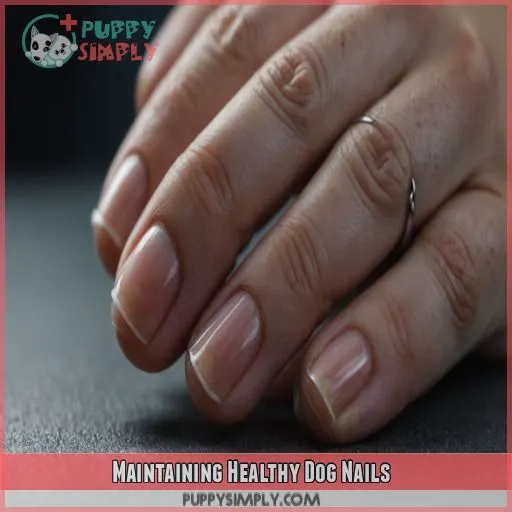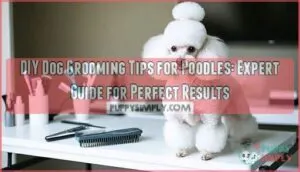This site is supported by our readers. We may earn a commission, at no cost to you, if you purchase through links.
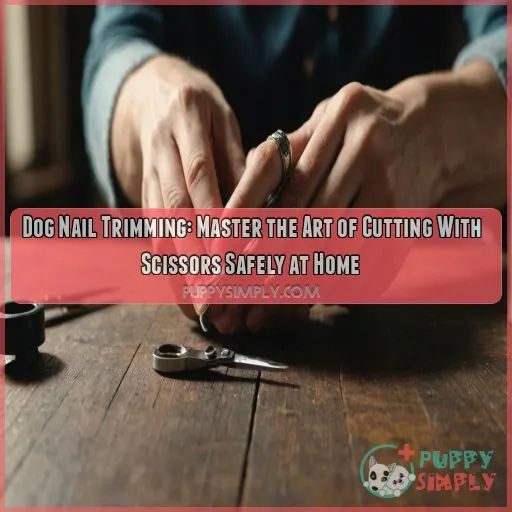
First, choose the right scissors-type trimmers specifically designed for dog nails.
To trim dew claws, hold your dog in a comfortable position and gently snip, taking care not to cut the quick. For dark-colored claws, use a flashlight to illuminate the nail.
Don’t worry if you’re nervous – it’s normal. Just remember to reward your dog with treats and praise for good behavior.
As you master the art of dog nail trimming with scissors, you’ll learn how to tackle even the toughest nails with confidence.
Table Of Contents
- Key Takeaways
- Preparing for Dog Nail Trimming
- Clipping Techniques for Dog Nails
- Trimming Dew Claws and Overgrown Nails
- Common Challenges and Solutions
- Maintaining Healthy Dog Nails
- Frequently Asked Questions (FAQs)
- How to trim dog nails with scissors?
- How to use scissors for dog grooming?
- What angle should I cut my dog’s nails?
- What position should I cut my dog’s nails?
- Can I use nail files instead of scissors for trimming?
- How do I desensitize my dog to nail trimming noises?
- What are the benefits of using a nail grinder tool?
- How do I choose the right scissors for my dogs nails?
- Can I trim my dogs nails when they are pregnant?
- Conclusion
Key Takeaways
- Don’t stress if you’re new to trimming your dog’s nails; with practice, you’ll become a pro! Just remember to choose the right scissors-type trimmers, specifically designed for dog nails, and take your time when trimming those pesky dew claws.
- To avoid cutting the quick (and the drama that comes with it), use a flashlight to illuminate the nail, especially for dark-colored claws. If you do accidentally cut the quick, don’t panic; just apply some styptic powder or cornstarch to stop the bleeding.
- When trimming, position your dog comfortably, and gently grip each toe with your thumb and forefinger to keep them steady. Cut at a 45-degree angle, from underneath, to prevent cutting too short and reduce the risk of bleeding.
- Make nail trimming a positive experience for your dog by rewarding them with treats and praise for good behavior. Schedule regular trimming sessions every 4-6 weeks to keep those nails healthy and prevent overgrowth, cracking, or dryness.
Preparing for Dog Nail Trimming
You’re about to begin a key aspect of dog grooming – nail trimming – and with the right preparation, you’ll be clipping like a pro in no time. To set yourself up for success, you need to choose the right clippers, get your dog accustomed to trimming, take necessary safety precautions, and have some tasty rewards on hand.
Choosing the Right Clippers
When choosing the right clippers for dog nail trimming, opt for a guillotine trimmer, which offers ease of use and safety features, especially for puppies and anxious dogs.
Getting Your Dog Accustomed to Trimming
Now that you’ve chosen the right clippers, it’s time to get your dog comfortable with nail trimming. Start early, ideally with puppy nail care, to make it a breeze.
Safety Precautions to Avoid Injury
To avoid injury, use dog-specific clippers, restrain your dog gently but firmly, and detect the quick to prevent painful cuts – keep styptic powder handy, just in case!
Rewards and Treats for Good Behavior
When trimming your dog’s nails, make it a positive experience with treats and praise. Reward good behavior to associate nail trimming with pleasant outcomes.
- Choose low-calorie treats to avoid overfeeding
- Reward your dog immediately after trimming each nail
- Use calming aids like pheromone diffusers to reduce stress
Clipping Techniques for Dog Nails
You’ve prepared your dog and yourself for nail trimming. Now it’s time to learn the clipping techniques that’ll make the process a breeze.
In this section, you’ll discover how to hold your dog in the right position.
You’ll also learn how to cut at the correct angle and avoid the quick to prevent bleeding. Don’t worry if you’re not familiar with the quick – it’s a common concern, and we’re here to guide you through it.
Holding Your Dog in the Right Position
When trimming your dog’s nails, drape your arms and upper body over them to hold them in place, using your left forearm to keep their head down.
Cutting at the Correct Angle
Now that you’ve got your dog in the right position, it’s time to focus on cutting at the correct angle – a vital step for safe and effective nail trimming.
Avoiding the Quick to Prevent Bleeding
Now that you’re cutting at the correct angle, it’s essential to avoid the quick. Look for a gray to pink oval and stop cutting to prevent painful bleeding.
Trimming Dark-Colored Claws Safely
When trimming dark-colored claws, visibility is key. To safely trim, try using a flashlight or lamp to illuminate the nail, and follow these handy tips:
- Use a nail trimmer with a safety stop to prevent cutting the quick.
- Trim a little at a time, taking breaks to assess the nail.
- Look for a slight color change, indicating the quick is near.
- Use a nail file to smooth out the edges and give a better view.
- If unsure, consult a veterinarian or professional groomer for guidance.
Trimming Dew Claws and Overgrown Nails
Now that you’re comfortable with the basics of nail clipping, it’s time to tackle those pesky dew claws and overgrown nails that can cause your dog discomfort and health issues. In this section, you’ll learn how to safely trim dew claws using scissors-type trimmers and get tips on filing nails without clippers for a smooth finish.
Identifying and Trimming Dew Claws
When trimming dew claws, you need to identify their location and type to avoid cutting the surrounding skin or quick. Here’s a handy guide to get you started:
| Dew Claw Location | Dew Claw Type | Trimming Tips |
|---|---|---|
| Inner front leg | Attached by loose skin | Bend away from leg |
| Outer front leg | Held in place by ligaments | Trim with caution |
| Rear leg | May be absent or small | Check for presence |
Using Scissors-Type Trimmers for Dew Claws
To trim dew claws safely, use scissors-type trimmers specifically designed for this task, and follow proper scissor safety tips to avoid accidents and injuries.
Trimming Overgrown Nails to Prevent Health Issues
When trimming overgrown nails, prioritize your dog’s comfort and safety to prevent health issues like cracking or pain; trim regularly to promote healthy nail growth.
Filing Nails Without Clippers for a Smooth Finish
Now that you’ve trimmed those overgrown nails, it’s time for a smooth finish! Grab a dog nail file, like a metal or glass one, and gently file away any rough edges.
Common Challenges and Solutions
Now that you’ve got the basics of dog nail trimming down, it’s time to tackle some common challenges you might face, like cutting dark-colored nails or dealing with a wiggly pup. Don’t worry, with a few simple tips and tricks, you’ll be a pro at trimming your dog’s nails in no time, even when things get a little tricky.
Cutting Dark-Colored Nails With Ease
- Use a flashlight or lamp to illuminate the nail
- Cut in small increments to avoid cutting the quick
- Look for a gray to pink oval at the top of the cut surface
- Use a nail trimmer with a safety guard to prevent accidents
Stopping Bleeding With Styptic Powder or Cornstarch
If you accidentally cut the quick, don’t panic! Apply styptic powder or cornstarch to stop the bleeding. These magical powders will help your dog’s nail clot in no time.
Dealing With Wiggly or Anxious Dogs
Dealing with wiggly or anxious dogs? Don’t worry, it’s normal! Try these calming techniques to help your furry friend relax:
- Gradual Exposure: Gradually introduce nail trimming tools and processes.
- Desensitizing Touch: Massage your dog’s paws to reduce sensitivity.
- Restraint Methods: Use gentle, firm holds to keep your dog secure.
- Positive Reinforcement: Reward calm behavior with treats and praise.
Alternative Methods for Trimming Nails
If clipping isn’t your thing, don’t worry! You can try alternative methods like nail filing techniques, trimming with Dremel, or using nail grinding tools.
| Method | Description | Best for |
|---|---|---|
| Nail Filing | Use a file or sandpaper to smooth out nails | Small, sensitive dogs |
| Dremel Trimming | Use a Dremel tool to carefully trim nails | Thick, hard nails |
| Nail Grinding | Use a grinding tool to wear down nails | Dogs with quick anxiety |
| Laser Clipping | Use a laser to precisely clip nails | Dogs with dark-colored nails |
Maintaining Healthy Dog Nails
You’ve made it to the final stretch – maintaining those healthy dog nails requires some effort, but with a regular trimming schedule, you’ll be a pro in no time. By monitoring your dog’s nail health and growth, preventing cracking and dryness, and seeking professional help when needed, you’ll keep those paws happy and healthy.
Scheduling Regular Trimming Sessions
Now that you’ve mastered nail trimming, schedule regular sessions every 4-6 weeks to keep your dog’s nails healthy and prevent overgrowth, cracking, or dryness – mark those calendars!
Monitoring Nail Health and Growth
To keep your dog’s nails healthy, monitor their growth regularly. Look out for signs of nail fungus, uneven growth, or changes in color or texture.
Here are three things to check for:
- Nail discoloration: Are your dog’s nails turning yellow, brown, or black? This could indicate a nail fungus or infection.
- Nail shape: Are your dog’s nails becoming misshapen or curling under? This could be a sign of uneven growth or nail problems.
- Nail texture: Are your dog’s nails becoming brittle, soft, or crumbly? This could indicate a nail health issue that needs attention.
Preventing Cracking and Dryness With Trimming
By trimming your dog’s nails regularly, you’ll prevent cracking and dryness. Moisturize after trimming to keep those nails healthy and strong, especially during hot summer months.
Seeking Professional Help When Needed
Don’t hesitate to seek professional help from veterinary experts, groomers, or canine nail specialists if you’re unsure or uncomfortable trimming your dog’s nails – it’s always better to be safe!
Frequently Asked Questions (FAQs)
How to trim dog nails with scissors?
Don’t use scissors to trim your dog’s nails! Instead, opt for special dog nail clippers or a guillotine-type trimmer. If you must trim the dew claw, use a scissors-type trimmer, but be super cautious to avoid cutting the surrounding skin.
How to use scissors for dog grooming?
You’re ready to master dog grooming with scissors. For a safe and easy experience, start by getting your dog accustomed to the scissors and process, then use them specifically for trimming dew claws.
What angle should I cut my dog’s nails?
Cut your dog’s nails at a 45-degree angle, from underneath. This helps prevent cutting too short and reduces the risk of bleeding. Easy does it – take small, gentle cuts to keep those paws safe and healthy!
What position should I cut my dog’s nails?
When cutting your dog’s nails, position them so you can easily access each paw. Hold your dog firmly, with their head down, and gently grip each toe with your thumb and forefinger to keep them steady.
Can I use nail files instead of scissors for trimming?
You can definitely use nail files instead of scissors for trimming. In fact, filing is a great alternative, especially for dogs who hate the clippers. Just use a firm file, like a metal or glass nail file.
How do I desensitize my dog to nail trimming noises?
Don’t let nail trimming be a nail-biter! Desensitize your dog to the noise by starting with low-volume exposure, then gradually crank it up. Reward calm behavior, and remember, patience is a virtue – or a treat!
What are the benefits of using a nail grinder tool?
You’ll love using a nail grinder tool – it’s a total game-changer! With a grinder, you can smooth out your dog’s nails, reducing the risk of painful cuts and bleeding (Source).
How do I choose the right scissors for my dogs nails?
Don’t grab just any scissors for your pup’s nail trim! Choose dog-specific nail clippers, not human scissors. These special clippers are designed for a safe, easy trim, helping you avoid accidents and stress for both you and your furry friend.
Can I trim my dogs nails when they are pregnant?
When in doubt, err on the side of caution." Trimming your dog’s nails during pregnancy is generally safe, but consult your veterinarian for personalized advice to guarantee the health and well-being of both mom and pups.
Conclusion
By now, you’ve nailed the basics of dog nail trimming with scissors. Don’t be too hard on yourself if it takes time to get the hang of it – with practice, you’ll become a pro at dog nail trimming with scissors.
Remember to reward your furry friend with treats and praise.
Don’t hesitate to seek help if needed. You’ve taken the first step in the direction of a healthier, happier pup.
Keep those scissors sharp and those nails trimmed.

